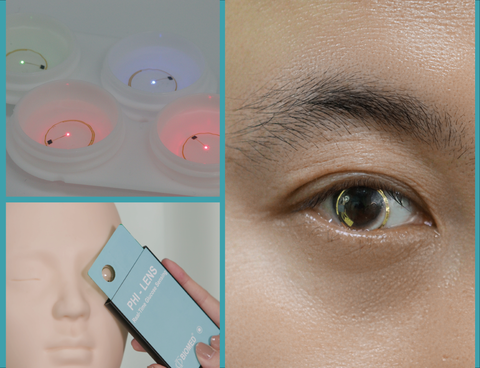Newspapers
 > Media News > Newspapers
> Media News > Newspapers | 제목 | 2022/08 [한세광 교수] Smart contact lens monitors blood sugar | ||
|---|---|---|---|
| 조회수 | 466 | 등록일시 | 2022-08-08 12:45:13 |
| 첨부파일 |
|
||
|
It is said a tear is an insight into a soul, but soon it could reveal multitudes about a person’s body chemistry, too. Researchers at Stanford University and POSTECH have developed a smart contact lens that quickly, accurately and continually monitors a person’s blood sugar.
If approved and commercialized, such lenses could have a “huge” clinical impact, the authors say in a paper published in the journal Advanced Materials. The smart lens holds the promise of not only continuous, non-invasive monitoring for hypoglycemia and hyperglycemia, but of delivering alerts and perhaps even treatments anytime blood sugar goes awry. As such, they stand to help tens-of-millions of people worldwide avoid dangerous, possibly fatal, side effects of high or low blood sugar — tremors, confusion, epileptic seizure, and coma. Chemistry is knowledge In the rapidly emerging field of wearable biometric devices, the glucose monitoring contact lens employs a clever combination of existing and cutting-edge technologies. Existing glucose detection devices worn on or just under the skin typically employ electrochemical sensors and a glucose-metabolizing enzyme—glucose oxidase—embedded in the wearable material. The engineers have succeeded with the addition of gold and platinum nanoparticles embedded in the polymer hydrogel that forms the contact lens. These hydrogels are porous. They absorb glucose-containing tear fluid from the eye surface and perform a simple chemical reaction. The gold and platinum serve as catalysts, expediting a reaction without getting used up themselves.

The engineers modified the gold and platinum particles adding hyaluronic acid that increases their distribution and long-term stability in the hydrogel. Likewise, the team fine-tuned the degree of porosity in the hydrogel. Tears are a precious commodity. Only a thin layer coats the eye. It’s a delicate balance. If the hydrogel is too porous, the structural integrity of the lens might be compromised. If it’s too impermeable, the lens might fail to absorb enough tear for successful measurement. Correctly engineered, however, the smart contact plays host to a multistep chemical reaction. At its most basic level, glucose in the tear undergoes a chemical reaction in the hydrogel that produces electricity. Circuits integrated in the lens then measure the strength of the electrical current and use it to calculate the amount of glucose in the tear—and by extension the blood. In technical terms, the chemical flavin adenine dinucleotide (FAD) from the enzyme reacts with the glucose in the tear to produce FADH2, among other chemical byproducts. FADH2 then reacts with oxygen, producing H2O2 (hydrogen peroxide). At this point the gold-platinum nanocatalyst comes into play, helping to split the H2O2 into its constituent elements, hydrogen and oxygen. Most critically, however, this splitting of hydrogen peroxide also releases two electrons. That is, it produces electricity. The electrons are conducted through the lens to an electrode sensor that calculates the amount of glucose in the blood. The strength of that electrical current is in direct proportion to the amount of glucose in the tear, which in turn is proportional to the amount of glucose in the blood—more electricity means more glucose. Measurement data are then transferred wirelessly from the lens to a smartphone.

Stability and accuracy The smart contacts are not the first wearable blood sugar monitoring system. There are sensors that can be worn on or embedded just under the skin, for instance. There have even been other contact lens approaches. But all have been challenged to deliver accurate and consistent results over relatively long periods of time required of wearable devices. The smart contact is the first glucose monitoring device to make a direct correlation between tear and blood glucose concentrations independently without aid of another medical device, such as a glucometer. Other continuous monitoring systems have, so far, have been hindered by technical challenges, including poor stability of the enzyme, low or inconsistent sensitivity of the glucose sensors, the relative low volume of tears with which to work, slow absorption of tears into the lens polymer for processing, and slow diffusion of the chemicals produced during the reaction. Subcutaneous sensors are also prone corrosion. So far, it has added up to a lot of promise, without much punch. The authors credit the improved porosity in their hydrogel with increasing diffusion of the reaction chemistry through the device. This improves sensitivity considerably, cutting response time by almost half and lowering by ten times the threshold at which glucose can be detected—all positive developments. Meanwhile, the addition of nanocatalysts greatly improves the crucial hydrogen peroxide-splitting reaction. The researchers have tested their smart lens in rabbits … and in a human. A volunteer from the research team served as a clinical trial of one. Results from those tests were at least as accurate as those made with a traditional glucometer, the authors say, reaffirming the promising feasibility of this smart contact lens in further clinical applications. The research team comprised a multi-institutional corps of researchers including authors Zhenan Bao and David Myung of the Department of Chemical Engineering at Stanford University; Cheonhoo Jeon and J.-Y. Sim of the Department of Electrical Engineering at Pohang University of Science and Technology (POSTECH) in South Korea; Su-Kyoung Kim, Geon-Hui Lee, Hye Hyeon Han, Seong-Jong Kim, and Sei Kwang Hahn of the Department of Materials Science and Engineering at POSTECH; Jee Won Mok and Choun-Ki Joo of the Department of Ophthalmology and Visual Science at The Catholic University of Korea in Seoul; and Sangbaie Shin and Sei Kwang Hahn of PHI BIOMED Co. in South Korea. |
|||
| 이전글 | 2022/06 [한세광 교수] 스마트기기 건강관리 기능, 믿고 사용해도 될까 |
|---|---|
| 다음글 | 2022/10 [한세광 교수,통합과정 이건희] 피, 땀 대신 눈물로...스마트 렌즈로 실시간 혈당 측정 |







